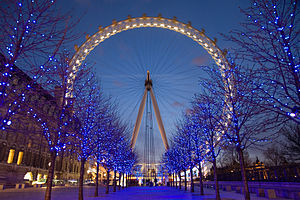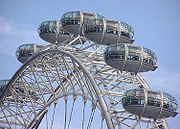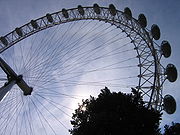
London Eye
Background Information
This content from Wikipedia has been selected by SOS Children for suitability in schools around the world. Child sponsorship helps children one by one http://www.sponsor-a-child.org.uk/.
| The London Eye | |
|---|---|
 |
|
| General information | |
| Location | Western end of Jubilee Gardens, on the South Bank of the River Thames, London, England |
| Height | |
| Roof | 135 metres (443 ft) |
| Design and construction | |
| Architect | David Marks, Julia Barfield, Malcolm Cook, Mark Sparrowhawk, Steven Chilton, Frank Anatole and Nic Bailey |
The London Eye, also known as the Millennium Wheel, is the largest Ferris wheel in Europe. It is described as an observation wheel by its operators. At the time it was erected it was the largest/tallest wheel in the world, however there are now larger wheels, such as The Star of Nanchang (160m) which opened in May 2006, and the Singapore Flyer (165m) which opened on February 11, 2008.
The London Eye stands 135 metres (443 ft) high on the western end of Jubilee Gardens, on the South Bank of the River Thames in London, England, between Westminster Bridge and Hungerford Bridge. It is located adjacent to the site of the former Dome of Discovery, which was built for the Festival of Britain in 1951.
The London Eye has become the most popular paid visitor attraction in the UK, visited by over 3 million people a year.
Design and construction
Designed by architects David Marks, Julia Barfield, Malcolm Cook, Mark Sparrowhawk, Shariq Varawalla, Sir Alexander Pulsford, Steven Chilton, Frank Anatole and Nic Bailey, the wheel carries 32 sealed and air-conditioned passenger capsules attached to its external circumference. Each capsule holds approximately 25 people, who are free to walk around inside the capsule, though seating is also provided. It rotates at 26 cm (10 in) per second (about 0.9 km/h (0.5mph) so that one revolution takes about 30 minutes. The wheel does not usually stop to take on passengers: the rotation rate is so slow that they can easily walk on and off the moving capsules at ground level. It is, however, stopped to allow disabled or elderly passengers time to embark and disembark safely.
The rim of the Eye is supported by tie rods and resembles a huge spoked bicycle wheel, and was depicted as such in a poster advertising a charity cycle race. The lighting for the London Eye was redone with LED lighting from Colour Kinetics in December 2006 to allow digital control of the lights as opposed to the manual replacement of gels over fluorescent tubes.
The wheel was constructed in sections which were floated up the Thames on barges and assembled lying flat on pontoons. Once the wheel was complete it was raised into an upright position by cranes, being lifted at 2 degrees an hour until it reached 65 degrees. It was left in that position for a week while engineers prepared for the second phase of the lift. The total weight of steel in the Eye is 1,700 tonnes (1,870 short tons). The project was truly European with major components coming from six countries: the steel was supplied from the UK and fabricated in The Netherlands by the Dutch company Hollandia, the cables came from Italy, the bearings came from Germany, the spindle and hub were cast in the Czech Republic, the capsules were made in France (and the glass for these came from Italy), and the electrical components from the UK. (Mann, Thompson, Smits, 2001)
History
It was opened by the Prime Minister, Tony Blair, at 20:00 GMT on December 31, 1999, although it was not opened to the public until March 2000 because of technical problems. Since its opening, the Eye, operated by Merlin Entertainments but sponsored by British Airways, has become a major landmark and tourist attraction.
By July 2002, roughly 8.5 million people had ridden the Eye. It had planning permission only for five years, but at that time Lambeth Council agreed to plans to make the attraction permanent.
Since 1 January 2005, the Eye has been the focal point of London's New Year celebrations, with 10-minute fireworks displays taking place involving fireworks fired from the wheel itself.
Following Merlin Entertainments purchase of the Tussauds Group in 2007, it owns 100% of the Eye, with British Airways continuing its brand association, and also having provided the original construction loans. The Tussauds Group, British Airways and the Marks Barfield family (the lead architects) had previously owned a third of the Eye each. However from the beginning of 2008 the name 'British Airways' was dropped from the logo.
During the bidding process of the 2012 Olympic Games, the London bid organisers announced the Olympic emblem would be attached to the Eye for the duration of the 2012 Summer Olympics.
In August of 2007, it was announced that London Eye could be temporarily renamed "The McCartney Eye" after Sir Paul McCartney of the Beatles. The renaming would coincide with the release of a McCartney related DVD set titled "The McCartney Years".
Financial controversy
On May 25, 2005, there were reports of a leaked letter showing that the South Bank Centre — owners of part of the land on which the struts of the eye are located — had served a notice to quit on the attraction along with a demand for an increase in rent from £65,000 per year to £2.5 million, which the operators rejected as unaffordable.
On 25 May 2005, London mayor Ken Livingstone vowed that the landmark would remain in London. He also pledged that if the row were not resolved he would use his powers to ask the London Development Agency to issue a compulsory purchase order. The land in question is a small part of the Jubilee Gardens, which was given to the SBC for £1 when the Greater London Council was broken up.
The South Bank Centre and the British Airways London Eye agreed a 25-year lease on February 8, 2006, after a judicial review over the rent row. The lease agreement meant that the South Bank Centre, a publicly-funded charity, would receive at least £500,000 a year from the attraction, the status of which is secured for the foreseeable future. Tussauds also announced the acquisition of the entire one-third interests of British Airways and the Marks Barfield family in the Eye, as well as the outstanding debt to BA. These agreements gave Tussauds 100% ownership of the Eye and resolved the debt from the Eye's construction loan from British Airways, which stood at more than £150 million by mid-2005 and had been increasing at 25% per annum.
Critical Reception
Sir Richard Rogers, winner of the 2007 Pritzker Architecture Prize, wrote of the London Eye in a recent book about the project,
| “ | The Eye has done for London what the Eiffel Tower did for Paris, which is to give it a symbol and to let people climb above the city and look back down on it. Not just specialists or rich people, but everybody. That's the beauty of it: it is public and accessible, and it is in a great position at the heart of London. | ” |
Writing for G2 in an article from August 2007, Steve Rose described the Eye as follows,
| “ | The Eye... exists in a category of its own.... It essentially has to fulfil only one function, and what a brilliantly inessential function it is: to lift people up from the ground, take them round a giant loop in the sky, then put them back down where they started. That is all it needs to do, and thankfully, that is all it does. | ” |
Predecessor
A predecessor to the London Eye, called the "Great Wheel of London", was built in Earl's Court in 1895. Capable of carrying 1,200 people, it closed in 1906.
The London Eye in popular culture
As a highly visual landmark, the London Eye is often used in popular culture, especially when London is used as a backdrop or a location for films and television.
Nearest rail and tube stations
National Rail
- Waterloo station
London Underground
- Embankment tube station (District, Circle, Bakerloo, Northern lines)
- Westminster tube station (Jubilee, District, Circle lines)
- Waterloo station (Waterloo & City, Bakerloo, Jubilee, Northern lines)
"River Bus" services
- Waterloo Pier (Tate and Tower Visitor services)




